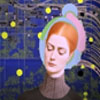
Between 1981 and 1984, Drs. Wambach and Snow, along with Dr. R. Leo Sprinkle of the University of Wyoming, offered over 2,500 Americans an opportunity to “progress” hypnotically to a future lifetime, in about either 2100 or 2300 A.D.
After gathering data and comparing notes, they discovered that the future-life progressions fell into four categories. These were:
(I) “In-space” habitats off of the Earth’s surface, either in space stations, spaceships or in experimental colonies on other planets;
(II) seemingly New Age communities on Earth, usually in the mountains or near the ocean shore;
(III) “hi-tech” urbanites, mostly living in artificially enclosed or underground cities; and
(IV) “rural survivors” in nineteenth-century-style villages along with six “urban survivors” living in the rubble of once-great cities.



In order to give readers as personal a glimpse as possible of the kind of future lives envisioned by those 2100 A.D. subjects who found themselves in a Type I space environment, I have chosen three reports as examples. Two are drawn from Helen Wambach’s 1980-84 workshops, and the third from one of my 1986 French groups.
A young woman from one of Helen’s workshops in the Midwest found herself returning as a male inhabitant of a “space research colony” that seemed to be located in the asteroid belt between Mars and Jupiter. Describing the atmosphere as “pleasantly cool and airy,” the man’s initial vision was limited to a “rather bare” observatory room. A clear bubble-like porthole, however, provided a glimpse of the stars against the black velvet backdrop of space. The “bright light” proved to be a distant star, apparently gone nova. The young man’s duties included studying its energy spectrum with quite sophisticated equipment.
Dressed in a “metallic but soft and stretchy” one-piece jumpsuit, the researcher described his white boots as coming equipped with “jet-propelled buttons for anti-gravity movement.” Brown-skinned, with cropped black hair, he mentioned his “strong, well-cared-for” hands and “medium build.” Later he found himself eating in what appeared to be a small communal dining room next to a blond woman whom he felt was his wife. A teenaged son sat nearby, while a few other adults took what looked like “prepackaged airline meal trays” from a machine in the corner of the room. Eaten with a single plastic “fork/spoon” utensil, the chunks of warm food reminded him of cubes of butter but were surprisingly tasty.
Asked to go for supplies, this space-colony dweller “walked down a long windowless hallway” to a storeroom. There an “Oriental-looking girl” provided him with several boxes, which he carried back to his laboratory. No money was exchanged; his signature was all that was required. He felt that a “universal charge” system handled payment. He also reported “knowing” that these prepackaged boxes of equipment were shipped to the colony via large space freighters, possibly of extraterrestrial origin. Food and water were manufactured (recycled?) locally in a central hydroponic garden unit that also served as a kind of recreational park when colony residents wanted to relax among more natural surroundings and greenery.
The seemingly placid surroundings and bland routine described by this Type I scientist seem to have masked underlying political unrest and intrigue, however. When asked to describe the circumstances of his death, he reported being “executed by lethal injection” while still in his early forties. Apparently he was involved in some kind of conspiracy against the prevailing political system. Unfortunately, the details of the incident were unclear. Nonetheless, Helen’s subject reported feeling that this future life was “left incomplete” by such an unnatural and premature death. It seemed likely that this soul would have to return for further human lifetimes to complete its learning experiences.
The second Type I scenario came from a Southern California housewife who reported a 2100 A.D. life spent as a spaceship pilot. Given Helen’s suggestion to “look down at your feet,” she found herself in a “young, Oriental male body” dressed in long, narrow, silver boots and a one-piece silvery flying suit with gloves. A form-fitting golden helmet with an adjustable clear-plastic face mask completed the outfit. Although the body seemed youthful, the subject reported feeling that it was really quite elderly. Some artificial means were used to keep the exterior appearance young.
This subject’s initial impression as a spaceman was looking out of his craft’s cockpit into the docking bay of a much larger space vessel. Side portholes let in artificial light. The front of the man’s ship was a large triangle that could apparently be darkened or made translucent as required. Reclining on a “pilot’s couch” directly under the now-clear triangular viewpoint, he was carefully steering his ship into its berth using a “clear ball that pivots.” Other similar craft were lined up in rows around the huge docking bay of the mother ship. The activity was routine: “I’ve done it many times,” the subject wrote.
This spaceman’s occupation seems to be that of a shuttle pilot, for the answers to the series of questions concerning his home life revealed that he had a studio apartment in a row of square buildings set in what seemed a dome-covered city in Siberia. His evening meal consisted of “just wafers and stuff.” He shared it with another, smaller individual who had “grayish skin” and wistful childlike eyes. Perhaps it was an extraterrestrial humanoid; the impression was not completely clear. In any case, the two acted as if they knew each other well. The smaller person was said to have “a sweet face.”
Unfortunately, this person was unable to recall going for supplies so that information is missing. Drifting in and out of conscious awareness often happens during such group progressions and in past-life regressions as well. His eventual death came from an in-space accident. Apparently a careless misstep during some kind of spaceship maneuver knocked him off balance and he fell down a ladder, crushing his chest. Death arrived as a welcome relief, for by that time this space pilot’s life had become a boring routine, seemingly devoid of family or any other significant emotional ties. This subject concluded: “It was a very limited and unhappy life by then [time of death].”
The third Type I report chosen came from a forty-year-old Frenchman with a diploma from Paris’ prestigious École des Beaux Arts. Part of a group that I progressed to the future during 1986, his data sheet was one of the seven that reported 2100 A.D. lives in an androgynous body. As such I thought it interesting to describe further. For convenience I will use masculine pronouns for his story.
Like most of the other space travelers, Pierre (not his real name) found himself wearing tight-fitting metallic clothes and flexible boots. “His” dark hair was cut short, apparently to fit under a space helmet, which he did not have on at the time as he was already inside a “space platform” orbiting the Earth. Unable to detect any visible secondary sex characteristics, such as breasts, he reported that he felt his body was essentially androgynous. Gender didn’t seem to matter very much.
Invited to “look up and become aware of your surroundings,” his initial view was along a “vast curving corridor without view ports,” which separated the station’s spherical working and living “pods.” Apparently he was heading “home,” for he next described his quarters as being two small interior rooms with “artificial windows” looking out on illusory holographic outdoor scenes that could be changed to suit one’s mood. The climate-controlled atmosphere could also be altered from cool to warm as desired. Apparently he lived there alone. Meals were eaten in a communal dining room. While there he saw other station personnel, noting that he felt closest to an older man whom he took to be his work supervisor. All the food was processed and tasted “bland.”
“Gliding along illuminated corridors” to an equipment depot was Pierre’s response to the question of how he traveled to get supplies. Like many other Type I subjects, he reported obtaining some sealed plastic-looking cartons there. Whatever he needed was apparently inside; perhaps it had been previously ordered. He registered receipt of the boxes on his wristwatch computer. The supply system seemed automated.
Unlike the other two Type I reports given above, however, Pierre’s 2100 A.D. death was nonviolent. It involved some kind of illness whose most notable symptoms were skin ulcers and sores. Although no age of death was given, the sickness described seemed more likely to be space-related than due to old age. He reported a feeling of “liberation” on leaving his future-life body.
The second 2100 A.D. group (Type II) represents what I would like to think of as the budding of a New Age here on the Earth. All of the twenty-four subjects in this group reported living on the planetary surface and having unrestricted contact with a natural environment. Nine described green, rolling hills covered with trees and shrubs. Four indicated living among high mountains (the Andes and Himalayas), with another three next to the ocean. Three described a planned urban environment and one a desert monastic-style retreat. Five others gave less precise descriptions of their surroundings but their reports clearly showed them living in a natural Earth setting. Consequently they were included in Type II.
Virtually all of these New Age dwellers used highly positive descriptive adjectives when commenting on the climate and environment surrounding their communities. Fourteen specifically mentioned finding themselves amid “green” or “lush” lawns and gardens while half described their environment as “pretty” or “well cared for.” In general Type II subjects indicated living in temperate climes with fresh, breathable air. Warm sunny weather or brisk ocean or mountain breezes were frequently cited on their data sheets. The following two comments were typical:
“The climate was warm and moist, always comfortable. The landscape was clean and free from litter; it looked well-groomed with trees and shrubs carefully and skillfully landscaped. The buildings are beautifully planned; a simplistic but artful architecture.”
“I was in the mountains—windy and cool. It was summer; many trees and heavy foliage. There were steep valleys and rocks with small flat areas. It was a school for children in a convent-like complex; wing-shaped modern buildings jutting out of the mountainside. . . . I was a teacher in the “school of the healing sisters.”
Of the four 2100 A.D. environments discovered, those who experienced Type II New Age life-styles were by far the most satisfied with their future surroundings. Nearly all the spontaneous comments from this group about their future life experience were positive. The following remarks are representative:
“I felt very positive and contented about my surroundings. … It was sad to leave.”
“The voice of the Supreme Being gave me instructions as to lead or teach the people of the town and how to divide the work, food. . . . The comfort of the light was overpowering with hope and confidence.”
“I said “good-bye old man,” on leaving my body. … I then went to a much more crowded place!”
Only one subject made a specifically negative comment about her future New Age life-style. She said, “I was somewhat depressed and I felt a cold environment in my home.” Interestingly, hers was the only Type II data sheet to report an accidental death (at the young age of 35).
I have chosen two individual accounts, one from a 1983 workshop led by Helen Wambach and one from a 1987 workshop I gave near Los Angeles, to present in more detail here.
A delightful complex of “spherical and tall, white stone” buildings set among a “lush rolling lawn” with fir trees dotting surrounding hills greeted one of Helen’s 1983 workshop participants when asked to “look up and see your surroundings.” She had already noticed that this 2100 A.D. lifetime would be lived as a slender white male with “short, curly and dark” hair and “long, artistic hands.”
Realizing his name in that future life was “John,” there was an “aura of peace and serenity” about him as he walked along a smooth stone path clad in sandals “with straps up the legs to hold them on” and a soft, loosely draped muslin tunic whose folds fell to “about mid-calf.” A beautiful “deep blue, almost violet” sky, punctuated by an occasional small puffy cloud, stretched overhead. It seemed like a crisp, clear morning in early spring. The exact location of this idyllic spot was unclear and didn’t seem to matter: “Although on Earth, I don’t think it is anywhere we know of today.”
Asked about his encounter with the “bright, shining light,” John reported seeing “a golden flying saucer with a bright metallic sheen” where the sun shone on it. “It was hovering overhead.” A “friendly, familiar” voice from the saucer spoke inside John’s mind, greeting him by name. It was a profoundly spiritual experience, yet apparently commonplace, for although John listened intently and almost reverently, his pace did not slacken. “It was instructing me about some lessons I was going to pass along to others in the town: things like how best to share our resources and how to cooperate more fully in some joint project.”
John’s own living quarters, high up in one of the towers, were as harmoniously arranged as the landscape below: “Everything was set in different shades of off-white, with marble floors and draped wall hangings and low, comfortable couches to sit on.” He shared them with his mate, a good-looking blond woman, two young children and an older man, possibly his wife’s father. Their evening meal consisted of fruits and vegetables, eaten by hand from gold-colored plates. Although the family didn’t seem to eat a lot, the meal was “completely filling” and “tasted great.” John felt “comfort and well-being” in his home.
Apparently a scholar, John found himself traveling in a small one-passenger hovercraft, “unlike anything we have today,” to a nearby library bookstore for his supplies. There he traded an “oddly shaped metallic coin” for some “books and writing materials.” The library was built “like a geometric [geodesic?] dome” and contained books, “printed on soft plastic” and audiovisual materials. “Everything was strangely quiet, as if we didn’t need to talk out loud to be understood,” he said.
According to Helen’s subject, the end of John’s life in the twenty-second century was as calm and deliberate as the rest. “I’m eighty-five and it’s time to go,” he noted. Thus, although “old age” was listed as the cause of death, it would seem that, as was widely reported by others living Type II life-styles, John chose to leave his physical body when he felt it had served its purpose. Death was seen as a necessary and desired transition, neither a tragedy nor a great relief.
The story told by a middle-aged California housewife who attended one of my 1987 workshops shared many of the features that “John” reported but with its own distinctive character. This woman described the outside environment as “warm and beautiful.” There were “colorful flowers” everywhere and “thick green lawns,” all irrigated by “an elaborate water system.” People wore a mixture of long, loose, flowing garments and short belted tunics, usually with sandals.
Nonetheless, it seemed as if most living quarters in her part of the Earth were either underground or “somehow shielded from the Sun’s rays, as if they were harmful to our skin.” This subject, who reported being a “strong but slender,” brown-haired woman named “Rhonda” in that lifetime, noted her skin was very pale, as if seldom exposed to sunshine.
Although never asked about their perception of the overall size of their community, a half dozen of the Type II subjects made spontaneous remarks that they noticed only a sparse population in their vicinity. Some indicated that there was something of an isolated feeling to their life. A typical comment was:
“In general, it felt lonely; not many people around although it was civilized, not chaotic.”
Other parallel remarks included:
“There were not a lot of others around. … I felt there was a small population only.”
“Not a lot of others around though I had a sense of sharing this place with two or three people. It was some sort of command research [computers or technical] or communal living area removed from the general population, if there is such a thing.”
Excerpt from Mass Dreams Of The Future
See Part II here.
